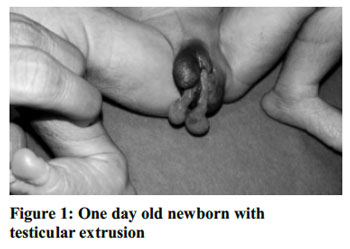Scrotoschisis – A Rare Congenital Anomaly In Newborn
Case Report
Abstract
Testicular exstrophy is a very rare congenital anomaly.The exact etiology of this condition is not known.Replacing the testis and repair of scrotum is needed and is associated with good prognosis.We report a case of scrotoschisis along with review of the literature.
Introduction:
Testicular extrusion through the scrotal wall is called Scrotoschisis.This is a rare entity with only few cases have been reported [1],[2],[3],[4].
Malposition of the testis outside of the line of its descent is supposed to be ectopic testis. Testicularectopia is a well accepted pathology of abnormal testicular descent [5].Common ectopic site is superficial inguinal pouch, while ectopic testis has also been found at perineum, femoral canal and contralateral inguinoscrotal region. When testis is extracorporeal and eviscerated through the scrotal wall it is named as scrotoschisis[6]. This is a rare congenital anomaly with only 10 cases, reported so far.
Case Report:
A newborn baby was noticed to have transverse breech at the base of the left scrotal wall with protrusion of the testis. The baby was active with no other abnormalities.The baby full term was born by the normal vaginal route. There was no history of any birth injury or injury to the scrotum after birth. Antenatal ultrasound showed no abnormality. Onexamination, the left testis was seen to be protruding from the scrotum, normal in size and appeared viable. The right testis was normal in size, viable and protruding out from the Scrotum. No other genitourinary abnormalities were seen.
Discussion:
Scrotoschisis, is a rare congenital anomaly in neonates.Most cases are unilateral and affect normal males.Etiology is not known.But many theories have been proposed for the development of this condition, but none is proved.The occurrence of meconialperiorchitis is the best theory available. Shukla et al.called it as extracorporeal ectopic occurring due to scrotal defect during descent of the testis [3]. Amnion rupture or adhesion/band spectrum is often cited as a probable factor in scrotoschisis. Abberent amnion bands, strands or sheets can cause disruption of morphogenesis in the abdominal wall [7]. The different techniques for scrotal fixation as in orchiopexy can be utilized. As the number is very small, no procedure is proved to be better over others. Jesus et al.reported Dennisbrowne trans-scrotal orchiopexy (eversion of tunica vaginalis with fixation in subdartos pouch) is associated with good results [2].
Conclusion:
Scrotoschisis seems to affect otherwise healthy newborn males with no associated illness requiring repositioning of eviscerated testis with scrotal repair. The immediate prognosis is good, but long term results need to be studied.
References:
1. Hadley GP, Wiersma R, Scrotoschisis. Pediatrsurg int. 1994;9:148-9.
2. Jesus LE, Dekermacher S, Filho JA Rocha LJ. Scrotoschisis: An extremely rare congenital uropathy. Uropathy 2012;79:219-21.
3. Premkumar MH, Colen JS, Roth DR, Fernandes CJ. Could scrotoschisis mimic an iatrogenic injury? A case report. Urology 2009;73:795-6.
4. Gongaware RD, Sussman AM, Kraebber D M, Michigan S. Scrotoschisis as a mechanism for extracorporeal testicular ectopia. J Prdiatrsurg 1991;26:1430-1.
5. Togami J, Radhskrishna J. Testicular extrusion due to scrotoschisis. Urology 2002;60:1112-3.
6. Premkumar MH, Colen SJ, Roth DR, Fernandez CJ. Could scrotoschisis mimic an iatrogenic injury? A case report. Urology 2002;73:795-6.
7. Jesus LE, Dekermacher S, Fiho JA, Rocha LJ. Scrotoschisis: An extremely rare congenital uropathy. Urology 2012;79:219-21.
Issue: July-September 2017 [Volume 6.3]

